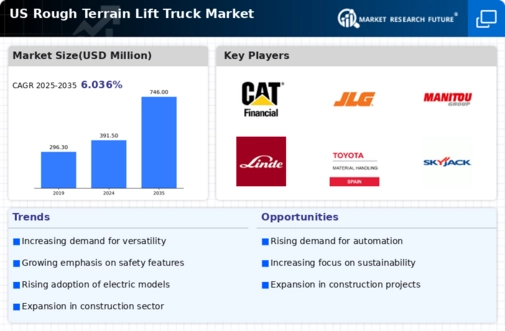Focus on Safety Regulations
The emphasis on safety regulations in the construction and agricultural sectors is significantly influencing the rough terrain-lift-truck market. As regulatory bodies enforce stricter safety standards, companies are compelled to invest in equipment that meets these requirements. This trend is particularly relevant in the US, where compliance with safety regulations is paramount. The rough terrain-lift-truck market is likely to see increased demand for trucks equipped with advanced safety features, such as stability control and operator protection systems. In 2025, the market for safety equipment in construction is projected to grow by 6%, reflecting the industry's commitment to ensuring worker safety. This focus on safety not only drives equipment upgrades but also enhances the overall market landscape.
Increased Construction Activities
The rough terrain-lift-truck market experiences a notable boost due to the rising construction activities across various sectors in the US. With infrastructure development being a priority, the demand for efficient lifting solutions is on the rise. In 2025, the construction industry is projected to grow by approximately 5.5%, leading to an increased need for specialized equipment like rough terrain-lift trucks. These trucks are essential for navigating uneven surfaces and challenging job sites, making them indispensable in construction projects. As companies seek to enhance productivity and safety, the adoption of rough terrain-lift trucks is likely to escalate, thereby driving market growth. The rough terrain-lift-truck market is poised to benefit significantly from this trend, as contractors invest in modern equipment to meet project demands.
Rising Demand for Rental Services
The trend towards equipment rental services is gaining traction in the rough terrain-lift-truck market. Many construction and agricultural companies prefer renting over purchasing due to the high initial costs associated with buying heavy machinery. This shift is particularly evident in the US, where the equipment rental market is projected to grow by 7% annually. As businesses seek flexibility and cost-effectiveness, the demand for rental rough terrain-lift trucks is likely to increase. This trend allows companies to access the latest technology without the burden of ownership, thereby driving the rough terrain-lift-truck market forward. The rental model also enables businesses to scale operations according to project needs, further enhancing market dynamics.
Expansion of Agricultural Operations
The agricultural sector in the US is undergoing a transformation, with an increasing emphasis on mechanization and efficiency. This shift is contributing to the growth of the rough terrain-lift-truck market. Farmers are increasingly adopting advanced machinery to enhance productivity, particularly in challenging terrains. The market for rough terrain-lift trucks is expected to expand as agricultural operations seek versatile equipment capable of handling various tasks, from lifting heavy loads to transporting materials across uneven fields. In 2025, the agricultural machinery market is anticipated to reach $50 billion, indicating a robust demand for specialized equipment. The rough terrain-lift-truck market stands to gain from this trend, as agricultural businesses invest in technology to improve operational efficiency and reduce labor costs.
Technological Innovations in Equipment
Technological advancements are playing a crucial role in shaping the rough terrain-lift-truck market. Innovations such as telematics, improved fuel efficiency, and enhanced safety features are becoming standard in modern equipment. These advancements not only improve operational efficiency but also reduce environmental impact, aligning with industry trends towards sustainability. In 2025, the market for telematics in construction equipment is expected to reach $2 billion, indicating a strong interest in technology integration. The rough terrain-lift-truck market is likely to benefit from these innovations, as companies seek to enhance productivity and safety on job sites. As technology continues to evolve, the demand for advanced rough terrain-lift trucks is expected to rise, driving market growth.




















Leave a Comment